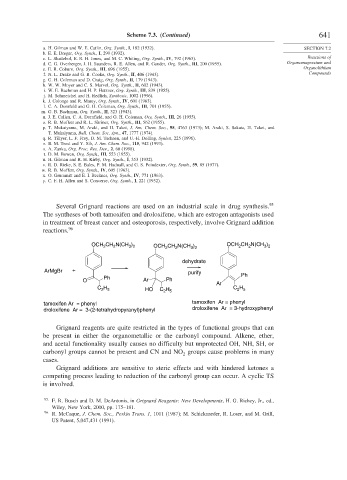Page 666 - Advanced Organic Chemistry Part B - Reactions & Synthesis
P. 666
Scheme 7.3. (Continued) 641
a. H. Gilman and W. E. Catlin, Org. Synth., I, 182 (1932). SECTION 7.2
b. E. E. Dreger, Org. Synth., I, 299 (1932).
c. L. Skattebol, E. R. H. Jones, and M. C. Whiting, Org. Synth., IV, 792 (1963). Reactions of
d. C. G. Overberger, J. H. Saunders, R. E. Allen, and R. Gander, Org. Synth., III, 200 (1955). Organomagnesium and
e. E. R. Coburn, Org. Synth., III, 696 (1955). Organolithium
f. N. L. Drake and G. B. Cooke, Org. Synth., II, 406 (1943). Compounds
g. G. H. Coleman and D. Craig, Org. Synth., II, 179 (1943).
h. W. W. Moyer and C. S. Marvel, Org. Synth., II, 602 (1943).
i. W. E. Bachman and H. P. Hetzner, Org. Synth., III, 839 (1955).
j. M. Schmeichel and H. Redlich, Synthesis, 1002 (1996).
k. J. Colonge and R. Marey, Org. Synth., IV, 601 (1963).
l. C. A. Dornfeld and G. H. Coleman, Org. Synth., III, 701 (1955).
m. G. B. Bachman, Org. Synth., II, 323 (1943).
n. J. E. Callen, C. A. Dornfield, and G. H. Coleman, Org. Synth., III, 26 (1955).
o. R. B. Moffett and R. L. Shriner, Org. Synth., III, 562 (1955).
p. T. Mukaiyama, M. Araki, and H. Takei, J. Am. Chem. Soc., 95, 4763 (1973); M. Araki, S. Sakata, H. Takei, and
T. Mukaiyama, Bull. Chem. Soc. Jpn., 47, 1777 (1974).
q. R. Tillyer, L. F. Frey, D. M. Tschaen, and U.-H. Dolling, Synlett, 225 (1996).
r. B. M. Trost and Y. Sih, J. Am. Chem. Soc., 115, 942 (1993).
s. A. Zanka, Org. Proc. Res. Dev., 2, 60 (1998).
t. D. M. Bowen, Org. Synth., III, 553 (1955).
u. H. Gilman and R. H. Kirby, Org. Synth., I, 353 (1932).
v. R. D. Rieke, S. E. Bales, P. M. Hudnall, and G. S. Poindexter, Org. Synth., 59, 85 (1977).
w. R. B. Moffett, Org. Synth., IV, 605 (1963).
x. O. Grummitt and E. I. Beckner, Org. Synth., IV, 771 (1963).
y. C. F. H. Allen and S. Converse, Org. Synth., I, 221 (1932).
Several Grignard reactions are used on an industrial scale in drug synthesis. 95
The syntheses of both tamoxifen and droloxifene, which are estrogen antagonists used
in treatment of breast cancer and osteoporosis, respectively, involve Grignard addition
reactions. 96
OCH CH N(CH ) OCH CH N(CH ) OCH CH N(CH )
2
3 2
2
3 2
2
2
3 2
2
2
dehydrate
ArMgBr + purify
Ph Ph
O Ar Ph
Ar
H C H
C 2 5 HO C H 2 5
2 5
tamoxifen Ar = phenyl tamoxifen Ar = phenyl
droloxifene Ar = 3-(2-tetrahydropyranyl)phenyl droloxifene Ar = 3-hydroxyphenyl
Grignard reagents are quite restricted in the types of functional groups that can
be present in either the organometallic or the carbonyl compound. Alkene, ether,
and acetal functionality usually causes no difficulty but unprotected OH, NH, SH, or
carbonyl groups cannot be present and CN and NO groups cause problems in many
2
cases.
Grignard additions are sensitive to steric effects and with hindered ketones a
competing process leading to reduction of the carbonyl group can occur. A cyclic TS
is involved.
95 F. R. Busch and D. M. DeAntonis, in Grignard Reagents: New Developments, H. G. Richey, Jr., ed.,
Wiley, New York, 2000, pp. 175–181.
96
R. McCaque, J. Chem. Soc., Perkin Trans. 1, 1011 (1987); M. Schickaneder, R. Loser, and M. Grill,
US Patent, 5,047,431 (1991).

